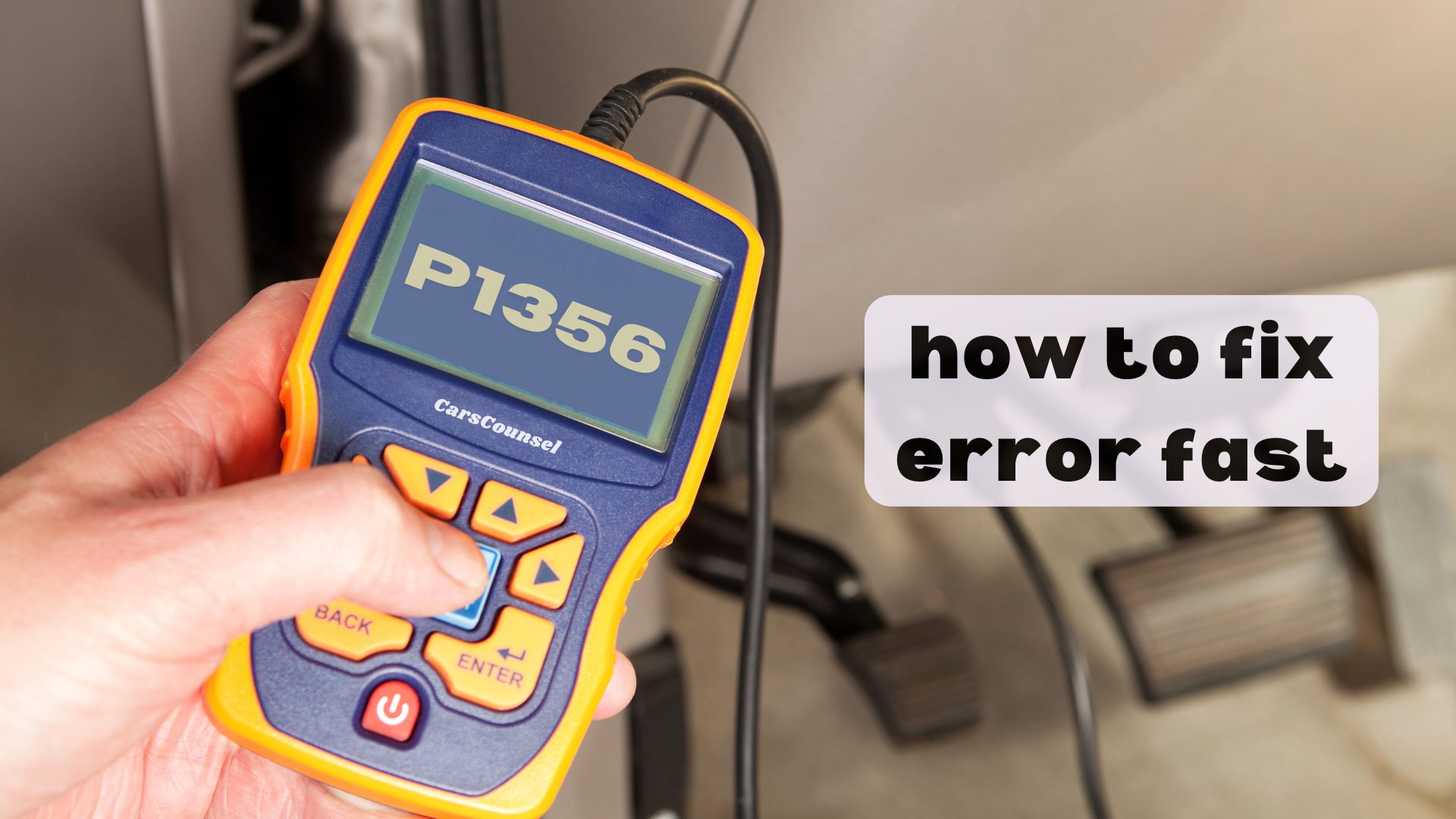When your car’s engine starts to stutter and stumble, it’s like a whispered secret: something’s amiss, but what? That’s exactly what happens when the P1356 code appears, signaling a loss of ignition diagnostic module input to the powertrain control module (PCM).
This error code is like a red flag, waving you down to investigate a problem that’s affecting your vehicle’s performance. Rough idling, misfires, and hesitation during acceleration are all symptoms of this issue, but what’s causing it? Is it a faulty ignition control module, spark plugs, or something else entirely? You’ll need to dig deeper to find the root of the problem.

Quick Navigation
Key Takeaways
- Code P1356 is triggered when the PCM stops receiving critical ignition system data, leading to performance issues and potential long-term damage.
- Faulty ignition system components, such as the ignition control module, coils, or spark plugs, are the primary causes of code P1356.
- Symptoms of code P1356 include rough idling, misfires, hesitation during acceleration, difficulty starting the vehicle, and a decrease in overall engine performance.
- To diagnose code P1356, conduct ignition system checks, perform wiring harness tests, and use a diagnostic scanner to retrieve trouble codes and monitor the ignition system’s performance.
- Repairing the issue involves inspecting and replacing faulty components, checking and repairing wiring and connections, and clearing the trouble code from the PCM’s memory.
Understanding Code P1356
When your vehicle’s onboard computer, the powertrain control module (PCM), stops receiving critical ignition system data, it triggers code P1356.
This code signals a communication issue between the ignition system and the PCM, which can lead to performance issues and potential long-term damage.
The ignition diagnostic module monitors the ignition system and provides feedback to the PCM for proper engine function.
Without this data, your vehicle’s performance will suffer. You may notice rough idling, misfires, or hesitation during acceleration, and difficulty starting the vehicle.
Understanding code P1356 is vital to addressing these issues and ensuring your vehicle runs smoothly and efficiently.
Common Causes of Failure
Faulty ignition system components are the primary culprits behind code P1356. You’ll need to identify the root cause to fix the issue. Common causes of failure include:
| Components | Failure Modes |
|---|---|
| Ignition Control Module | Failure to provide spark, faulty communication with PCM |
| Ignition Coils | Failing to generate spark, overheating |
| Spark Plugs | Worn out, fouled, or damaged, leading to misfires |
| Wiring and Connections | Corrosion, damage, or wearout, disrupting signal transmission |
| PCM | Faulty communication or processing of ignition system data |
These components can fail due to wear and tear, faulty manufacturing, or electrical surges. Ignition system failures, including spark plug wearouts, can lead to code P1356. By understanding these common causes, you can diagnose and repair the issue efficiently.
Identifying the Symptoms
Upon examining your vehicle’s behavior, you’ll notice specific symptoms that indicate code P1356 is present.
These symptoms often manifest as engine performance issues, such as rough idling or stalling, misfires or hesitation during acceleration, and difficulty starting the vehicle.
You may also experience a decrease in overall engine performance, which can be alarming.
Additionally, the Check Engine Light will likely illuminate, signaling that there’s an issue that needs attention.
Ignition issues can be frustrating, but identifying these symptoms is the first step towards resolving the problem.
Diagnosis and Inspection
Now that you’ve identified the symptoms of code P1356, it’s time to pinpoint the root cause of the issue.
You’ll need to perform a thorough diagnosis and inspection to determine the source of the problem.
Start by conducting ignition system checks to rule out any faulty components, such as the ignition control module, coils, or spark plugs.
Next, perform Wiring harness tests to identify any damaged or corroded wires that may be causing the communication issue.
Use a diagnostic scanner to retrieve any trouble codes and monitor the ignition system’s performance.
Repairing the Issue
With the diagnosis complete, you’re ready to tackle the repair.
Now that you’ve identified the issue, it’s time to address the root cause of the problem. To repair the P1356 code, you’ll need to focus on the ignition system, as it’s not communicating properly with the PCM.
Start by inspecting the ignition system components, looking for signs of wear or damage. Check the wiring and connections between the ignition system and PCM, verifying they’re secure and free from corrosion.
By repairing or replacing faulty components, you’ll restore proper communication between the ignition system and PCM, ultimately improving vehicle performance.
With the repair complete, clear the trouble code from the PCM’s memory and test drive the vehicle to confirm the issue is resolved.
Replacing Faulty Components
You’ve identified the faulty components in the ignition system, and it’s time to replace them.
Ignition Coil Failure and Spark Plug Wear are common culprits behind the P1356 code. When replacing the ignition coils, guarantee you purchase ones that meet the manufacturer’s specifications.
Spark Plug Wear can be diagnosed by inspecting the spark plugs for excessive wear or fouling. Replace them with new ones that match the recommended type and gap.
Remember to disconnect the battery before starting the replacement process to avoid any accidental engine starts. Once you’ve replaced the faulty components, reconnect the battery and clear the trouble code from the PCM’s memory.
Cost of Repair and Labor
Replacing faulty components is only part of the repair process; the cost of those parts and the labor required to install them can add up quickly.
You’ll need to factor in repair estimates, which can vary depending on the extent of the issue and labor rates at your local auto shop.
On average, you can expect to pay between $100 and $500 for replacing ignition control modules, coils, or spark plugs.
Additional costs may apply for wiring repairs, so budget at least $200 to $800 for parts and labor.
Labor rates can vary significantly between shops, so be sure to obtain quotes from multiple places to guarantee a fair price.
Resetting the PCM Memory
After addressing the faulty components and wiring issues, it’s time to clear the trouble code from the PCM’s memory.
You’ll need to use a diagnostic scanner to reset the PCM and clear the code. This process is known as PCM resetting or memory clearing. Connect the scanner to the vehicle’s OBD-II port and follow the manufacturer’s instructions to access the PCM’s memory.
Select the “clear codes” or “erase codes” option to remove the P1356 trouble code from the PCM’s memory. Once complete, the PCM will no longer store the code, and the Check Engine Light should turn off.
Now, take the vehicle for a test drive to verify the issue is resolved and the PCM is functioning properly.
More OBD-II Codes
Frequently Asked Questions
Can a Faulty Ignition Control Module Cause Other Trouble Codes?
You’ll likely see additional trouble codes if a faulty ignition control module is causing issues, as it can trigger symptoms like misfires, rough idling, and hesitation, indicating broader ignition system failures that require attention.
Will a P1356 Code Cause My Vehicle to Fail an Emissions Test?
As you prepare for your vehicle inspection, imagine the emissions test lights flashing red – a P1356 code will likely trigger a failure, as it can cause excessive emissions due to misfires, rough idling, and poor engine performance, violating emissions standards.
Can I Drive My Vehicle With a P1356 Code Without Causing Damage?
When driving with a faulty ignition system, you’re advised to exercise caution, as it may lead to unsafe operation. While it’s possible to drive, it’s not recommended, as it can cause further damage; instead, address the issue promptly to guarantee safe operation and prevent long-term problems.
Are There Any DIY Repairs for a P1356 Code Without Professional Help?
You can attempt DIY repairs for a P1356 code by cleaning the ignition module and performing DIY troubleshooting on the ignition system, but be cautious not to cause further damage and consider seeking professional help if unsure.
Will a Tune-Up or Spark Plug Replacement Fix a P1356 Code?
You’re wondering if a tune-up or spark plug replacement will fix the issue, but spark plug wear only affects ignition system performance, not the diagnostic module input loss, so it’s unlikely to resolve the problem on its own.
Conclusion
You’ve successfully diagnosed and repaired the P1356 code, but you might be thinking, “Will this fix last?” Rest assured, by addressing the root cause of the issue and replacing faulty components, you’ve restored reliable communication between the ignition system and PCM. This repair will indeed last, as long as you maintain your vehicle’s ignition system and address any underlying issues that may have contributed to the problem.

